- [Security OAuth2] Section 1. Spring Secuirty Fundamentals
- [Security OAuth2] Section 2. OAuth 2.0 용어 이해
- [Security OAuth2] Section 3. OAuth 2.0 권한부여 유형
- [Security OAuth2] Section 4. OAuth 2.0 Open ID Connect
- [Security OAuth2] Section 6. OAuth 2.0 Client Fundamentals
- [Security OAuth2] Section 7. OAuth 2.0 Client - oauth2Login()
- [Security OAuth2] Section 8. OAuth 2.0 Client - oauth2Client()
[Security OAuth2] Section 1. Spring Secuirty Fundamentals
스프링 시큐리티 초기화 과정
SecurityBuilder 는 빌더 클래스로서 웹 보안을 구성하는 빈 객체와 설정클래스들을 생성하는 역할을 하며 WebSecurity, HttpSecurity 가 있습니다.
SecurityConfigurer 는 Http 요청과 관련된 보안처리를 담당하는 필터들을 생성하고 여러 초기화 설정에 관여합니다. SecurityBuilder 는 SecurityConfigurer 를 포함하고 있으며 인증 및 인가 초기화 작업은 SecurityConfigurer 에 의해 진행됩니다.

아래 그림과 같이 AutoConfiguration 이 SecurityBuilder 의 build() 를 호출하는데요. 이 때 SecurityBuilder 는 내부적으로 SecurityConfigurer 를 가지고 있으면서 build() 가 실행되는 동안 초기화작업을 진행합니다.

이것을 좀 더 상세히 보겠습니다.
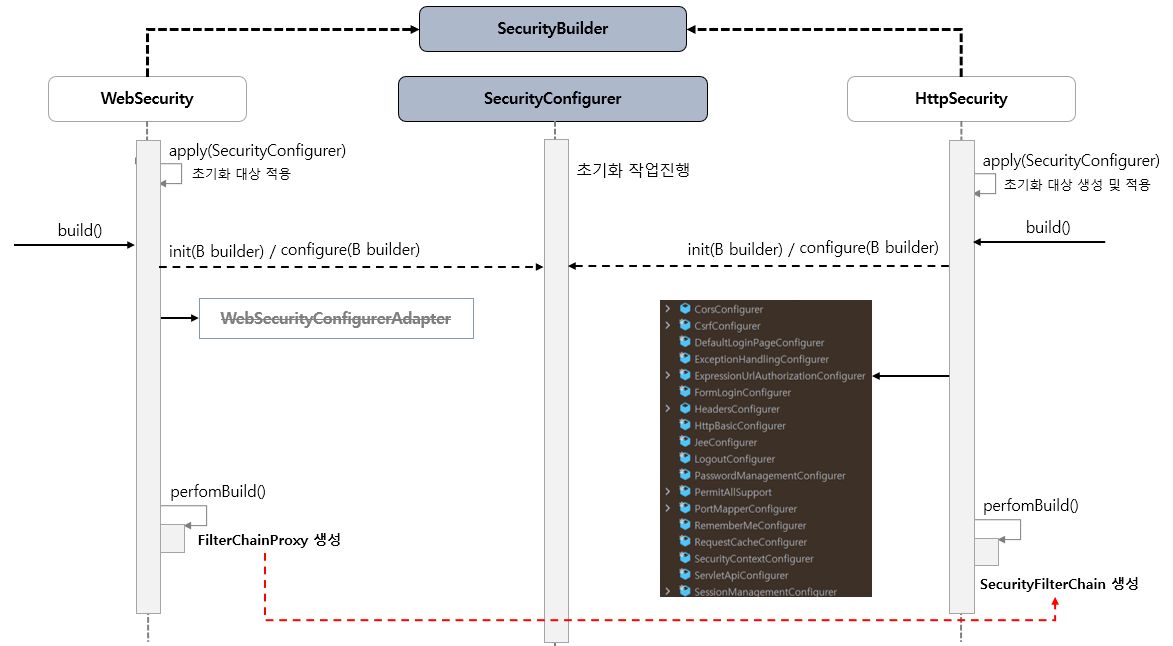
SecurityBuilder 는 WebSecurity 와 HttpSecurity 구현체가 있습니다. 먼저 apply() 메서드로 초기화 대상을 적용시킵니다. 그래서 어떤 Cnofigurer 를 초기화할지 대상을 정하게 됩니다.
이후 build() 메서드가 호출되고, 그 안에서 각각의 Configurere 들의 init(), configure() 메서드가 호출되면서 그 안에서 Filter 도 만들고 인증과 인가에 필요한 객체를 만듭니다.
WebSucurity 의 최종 반환값은 FilterChainProxy 입니다. 그리고 HttpSecurity 의 최종 반환값은 SecurityFilterChain 입니다.
WebSecurityConfiguration
해당 Config 파일의 setFilterChainProxySecurityConfigurer() 메서드에서 WebSecurity 클래스를 만듭니다.
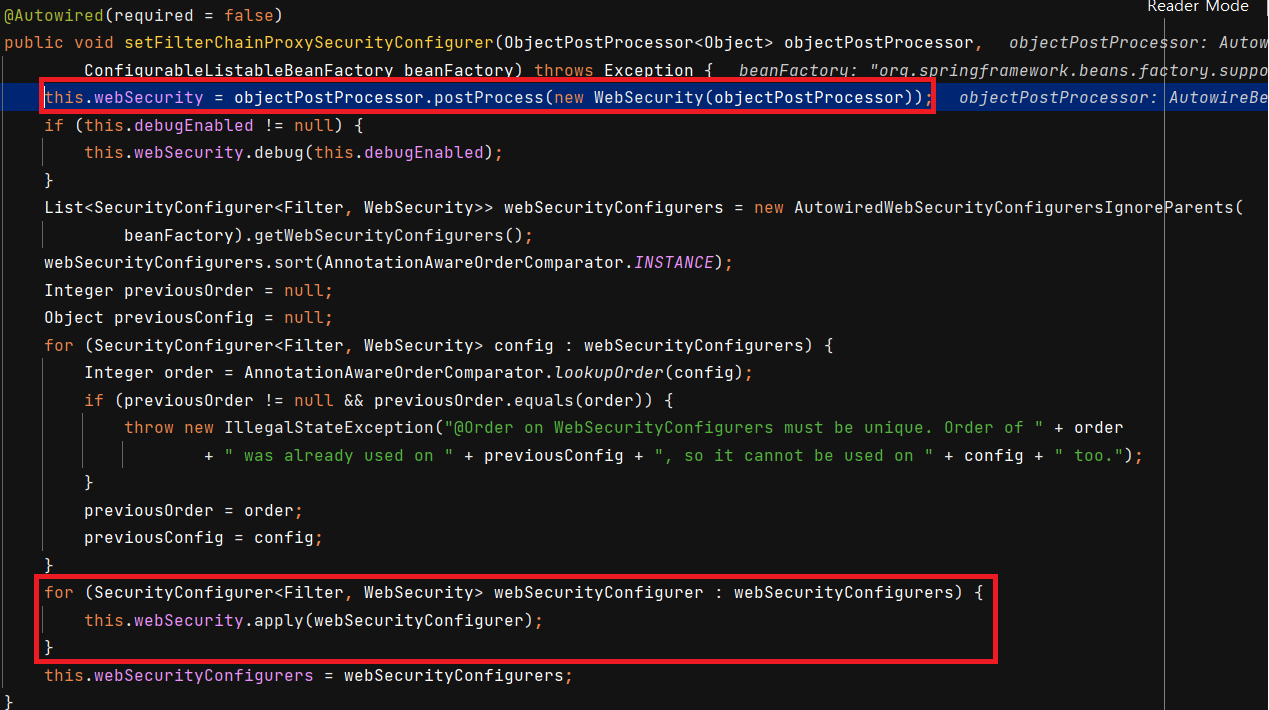
첫 번째 박스에서 WebSecurity 를 만드는 것을 볼 수 있고, 두 번째 박스에서는 SecurityConfigurer 를 apply() 메서드로 적용시키고 있습니다.
HttpSecurityConfiguration
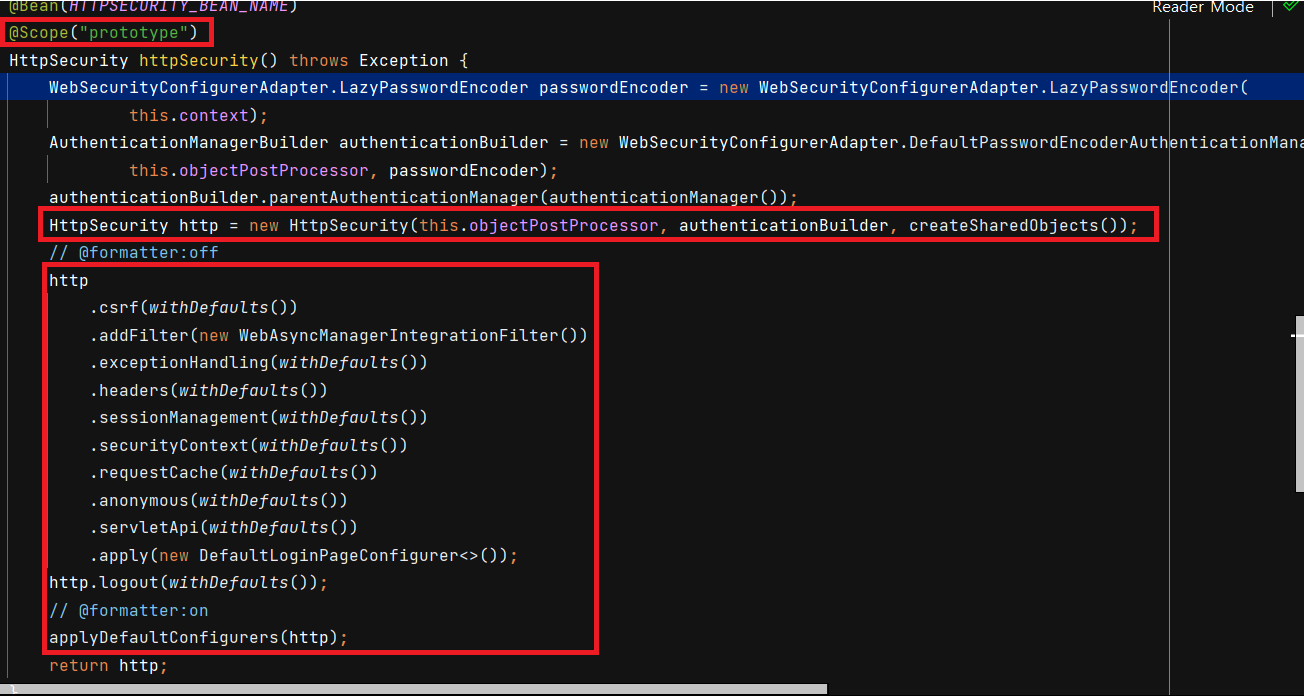
HttpSecurity 는 scope 가 prototype 으로, 여러 개를 생성할 수 있습니다. 세 번째 박스를 보면 Default 구현체를 생성하고 적용시키고 있습니다.
예를 들어 .csrf() 메서드를 보면,

이렇게 되어있는데, getOrApply() 메서드로 들어가서 다시 apply() 로 들어가면, AbstractConfiguredSecurityBuilder 클래스의 apply() 메서드를 적용하고 있습니다. 여기에서 Configurer 를 추가해줍니다.
아래와 같이 HttpSecurityConfiguration 의 configurers 필드에 CsrfConfigurer 가 추가된 걸 볼 수 있습니다.
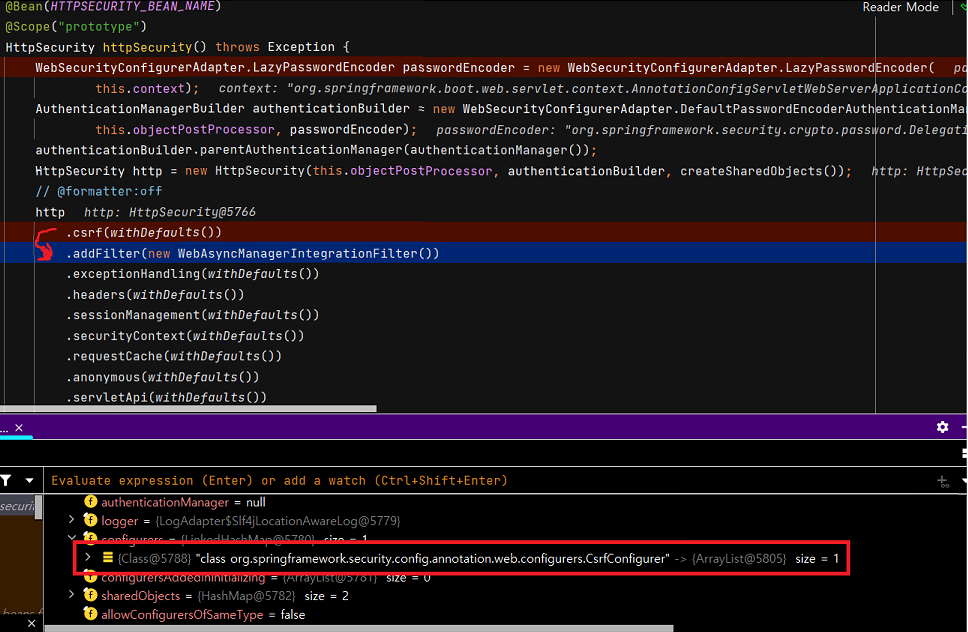
그렇다면 이렇게 구성된 http 는 어디서 빈으로 등록될까요? 바로 SpringBootWebSecurityConfiguration 클래스입니다.
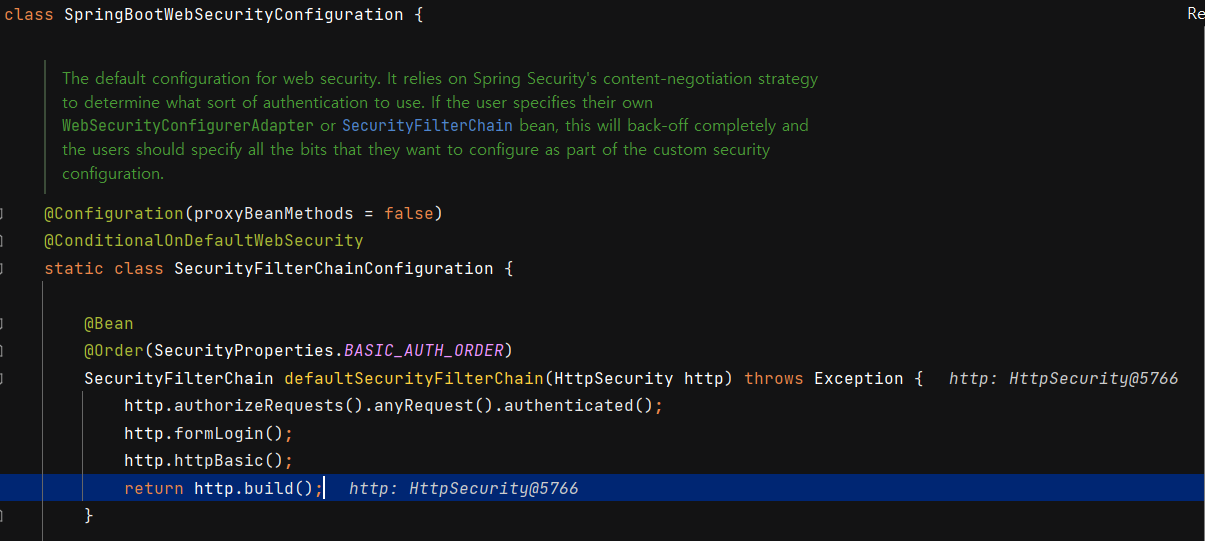
해당 클래스에서 기본적인 SecurityFilterChain 을 빈으로 등록합니다.
여기서 build() 를 하게 되면 AbstractSecurityBuilder 의 build() 메서드가 사용되는데요. 해당 메서드 내부에서는 doBuild() 를 사용합니다.

doBuild() 내부에서는 configurers 를 가지고 여러 가지 초기화 과정이 시작됩니다.
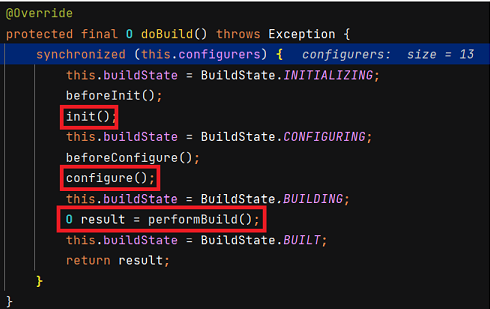
init() 메서드에는 각 configurer 의 init() 메서드를 호출합니다.

그리고 configure() 메서드에서는 각 configurer 의 configure() 메서드를 호출합니다.

예를 들어, 아래는 CsrfConfigurer 의 configure() 메서드입니다.
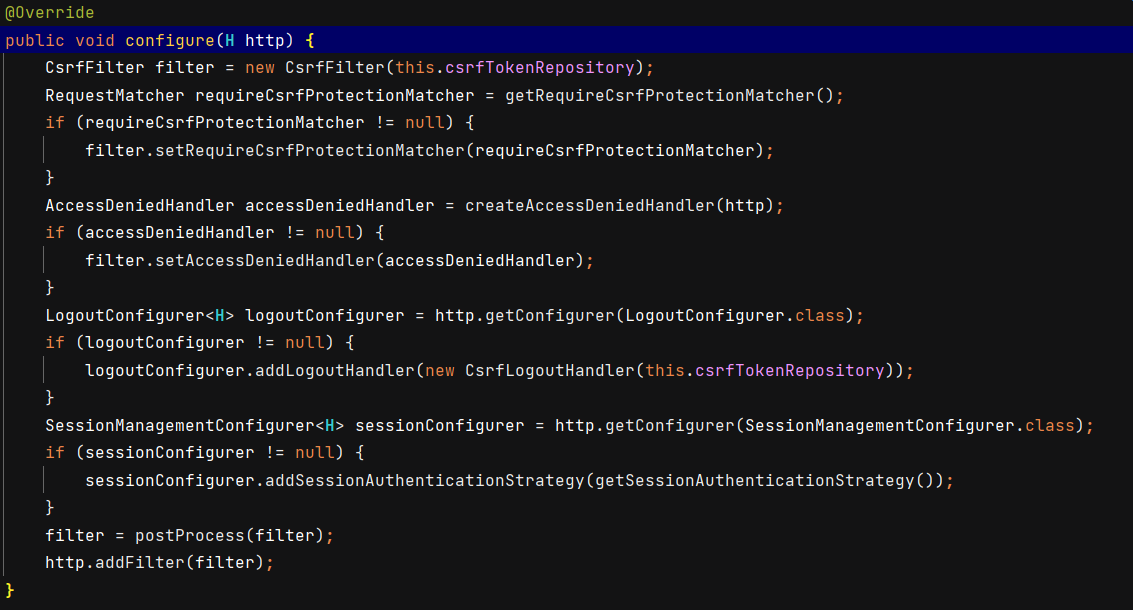
메서드 내부에서 필터, 핸들러 등을 만들고 addFilter 를 합니다.
마지막으로 performBuild() 는 HttpSecurity 에 있고 DefaultSecurityFilterChain 을 리턴합니다.

DefaultSecurityFilterChain 은 만들어진 필터(sortedFilters) 와 requestMatcher 를 받고 있습니다. requestMatcher 는 SpringBootWebSecurityConfiguration 에 있습니다. (http.authorizeRequests().anyRequest().authenticated();)
이렇게 만들어진 Filter 들은 WebSecurity 로 전달되어 FilterChainProxy 를 만드는 데 사용됩니다. WebSecurity 에도 performBuild() 가 동작하는데, 해당 메서드에서 FilterChainProxy filterChainProxy = new FilterChainProxy(securityFilterChains); 형태로 securityFilterChains 가 전달됩니다.
CustomSecurityConfigurer
CustomSecurityConfigurer 은 AbstractHttpConfigurer 를 상속받아야 합니다. 제네릭 타입은 아래와 같이 만듭니다.
public class CustomSecurityConfigurer extends AbstractHttpConfigurer<CustomSecurityConfigurer, HttpSecurity> {
private boolean isSecure;
@Override
public void init(HttpSecurity builder) throws Exception {
super.init(builder);
System.out.println("init method called ... ");
}
@Override
public void configure(HttpSecurity builder) throws Exception {
super.configure(builder);
System.out.println("configure method called ... ");
if(isSecure){
System.out.println("https is required");
}else{
System.out.println("https is optional");
}
}
public CustomSecurityConfigurer setFlag(boolean isSecure){
this.isSecure = isSecure;
return this;
}
}
간단하게 init() 과 configure() 를 구현했습니다. isSecure 값은 Config 파일에서 줍니다.
SecurityConfig
@Configuration
public class SecurityConfig {
@Bean
public SecurityFilterChain securityFilterChain(HttpSecurity http) throws Exception {
http
.authorizeRequests()
.anyRequest().authenticated()
.and()
.formLogin()
.and()
.apply(new CustomSecurityConfigurer().setFlag(true));
return http.build();
}
}
.setFlag(true) 를 통해 메서드 체이닝 방식으로 isSecure 값을 줍니다. 빌드를 하면 다음과 같이 작동합니다.

자동설정에 의한 초기화 과정
자동설정에 의해 초기화를 진행하면 아래와 같은 과정으로 진행됩니다.

- 어떤 조건에 따라 빈을 등록하는 로직을 구현하려면
SpringWebMvcImportSelector을 사용합니다. SecurityFilterAutoConfiguration클래스는DelegatingFilterProxyRegistrationBean클래스를 만듭니다. 그러면 그 빈 클래스가DelegatingFilterProxy를 등록합니다.- 이후
WebMvcSecurityConfiguration은 여러ArgumentResolver를 생성하는데 이중AuthenticationPrincipalArgumentResolver는@AuthenticationPrincipal에Principal객체를 바인딩합니다. HttpSecurityConfiguration에서는 프로토타입 빈인SecurityFilterChain빈을 생성합니다. 아래와 같이 각각의 Configurer 가 등록되고 초기화과정을 통해 각각의 필터가 만들어집니다.

예를 들어서 UsernamePasswordAuthenticationFilter 는 FormLoginConfigurer 에서 만듭니다.
SpringBootWebSecurityConfiguration 에 의한 자동설정
아래는 WebSecurity 가 만들어지는 과정입니다.
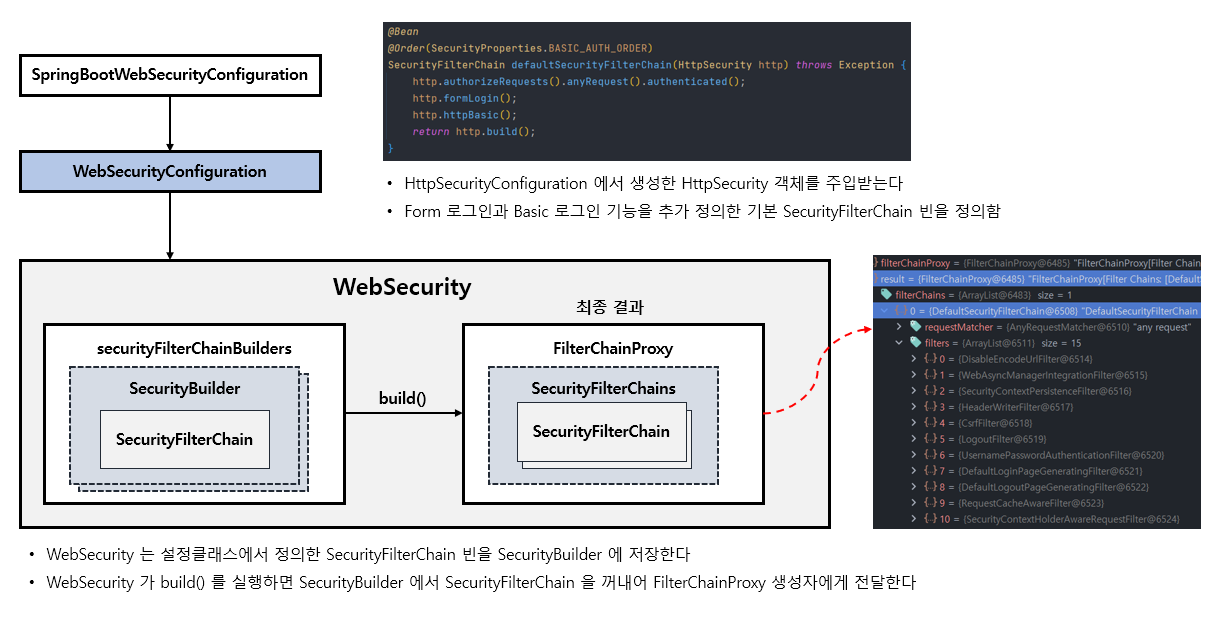
WebSecurity 에는 securityFilterChainBuilders 라는 필드가 있는데, 여러 개의 SecurityBuilder 가 들어갈 수 있습니다. 그리고 SecurityBuilder 는 SecurityFilterChain 을 가지고 있는데, 그게 바로 빈으로 등록한 SecurityFilterChain 입니다.
초기화 과정에서 WebSecurity 가 build() 를 실행하면 FilterChainProxy 를 생성합니다. FilterChainProxy 는 SecurityFilterChains 필드가 있는데, 여러 개의 SecurityFilterChain 을 가집니다.
최종적으로, SecurityFilterChain 빈들은 FilterchainProxy 안에 위치하게 됩니다.
코드레벨
SpringWebMvcImportSelector

먼저 selectImports() 메서드를 통해 DispatcherServlet 이 있는지 확인하고 있다면 ~WebMvcSecurityConfiguration 을 반환합니다.
SecurityFilterAutoConfiguration
그 다음으로 SecurityFilterAutoConfiguration 의 securityFilterChainRegistration() 메서드를 보면 DelegatingFilterProxyRegistrationBean 을 만들고 있습니다.

이 때 DEFAULT_FILTER_NAME 은 springSecurityFilterChain 입니다.
WebMvcSecurityConfiguration
그리고 resolver 를 등록시키는 addArgumentResolvers() 메서드입니다.

SpringBootWebSecurityConfiguration
해당 클래스에서 SecurityFilterChain 을 만들고 있습니다.

여기서 참조하는 HttpSecurity 는 HttpSecurityConfiguration 에서 프로토 타입 빈으로 생성됩니다.
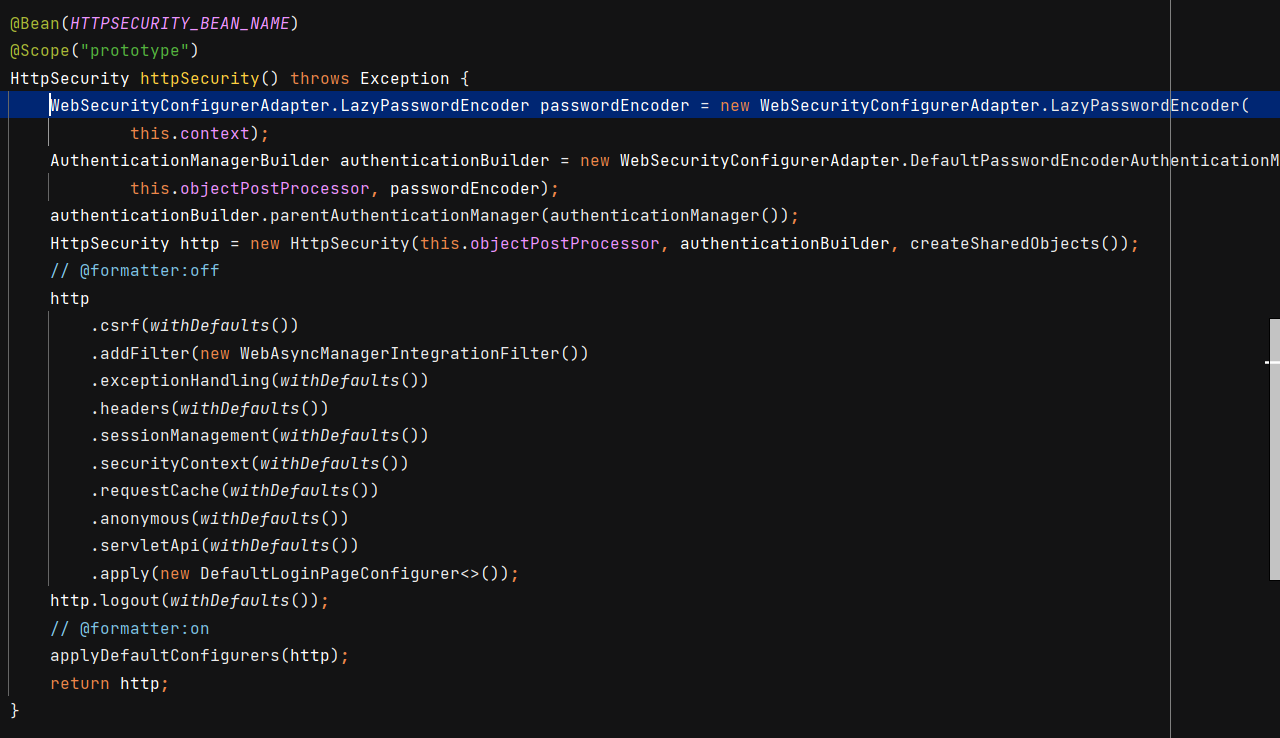
SpringBootWebSecurityConfiguration 를 다시보면 @ConditionalOnDefaultWebSecurity 라는 어노테이션이 있습니다.
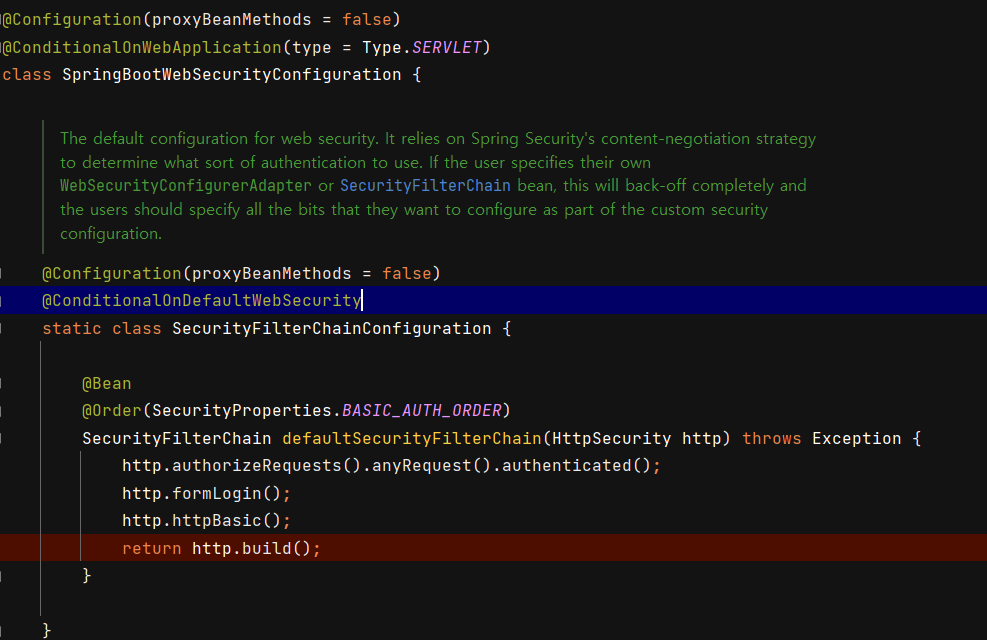
해당 어노테이션은 빈 등록은 어떤 조건일 때 하는지 정해놓는데요.

@Conditional 조건이 있습니다. DefaultWebSecurityCondition 클래스로 들어가보겠습니다.
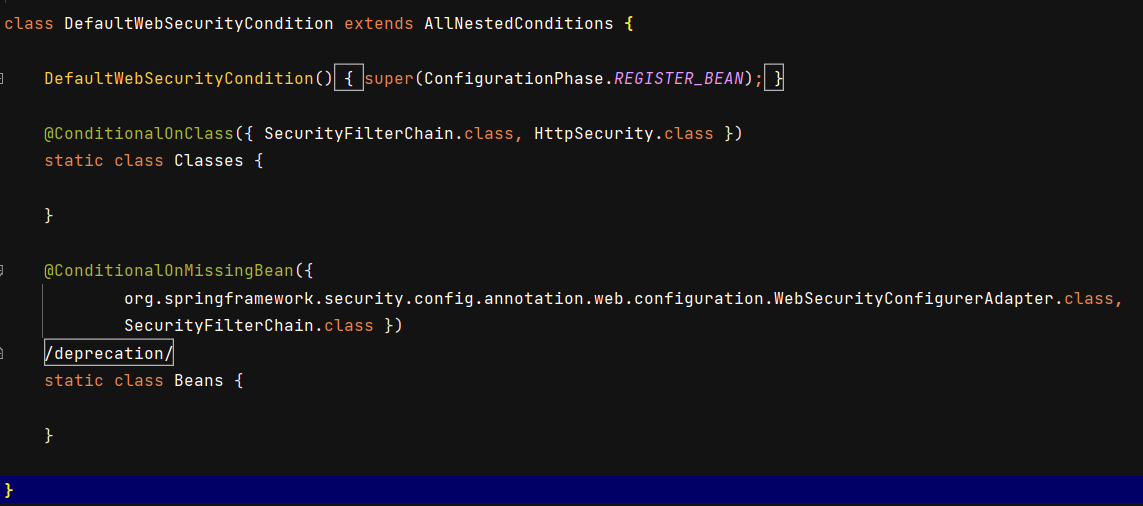
첫번째 조건은 classpath 에 SecurityFilterChain, HttpSecurity 가 잡혀져있느냐 이고, 두번째는 WebSecurityConfigurerAdapter, SecurityFilterChain 이 빈으로 등록된 게 없느냐 입니다.
WebSecurityConfiguration
해당 클래스의 setFilterChains() 메서드를 통해 필드값으로 securityFilterChains 를 받습니다.

그리고 반환 타입이 Filter 인 springSecurityFilterChain() 을 실행합니다.
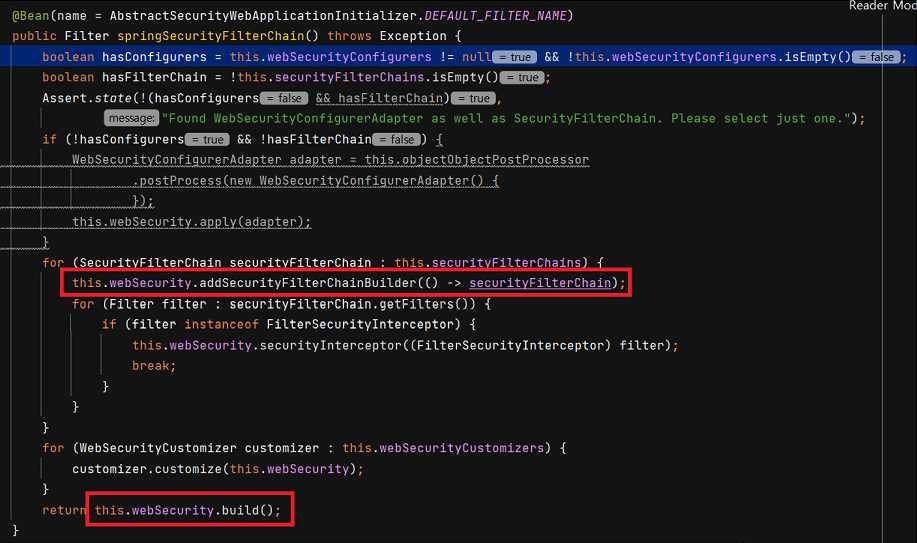
webSecurity 에 FilterChain 을 주고 build() 를 하면 최종적으로 FilterChainProxy 가 반환됩니다.
custom SecurityFilterChain 등록
아래와 같이 SecurityFilterChain 을 2개 만들어보겠습니다.
@Configuration
public class SecurityConfig {
@Bean
public SecurityFilterChain securityFilterChain1(HttpSecurity http) throws Exception {
http
.authorizeRequests()
.anyRequest().authenticated()
.and()
.formLogin()
;
return http.build();
}
@Bean
public SecurityFilterChain securityFilterChain2(HttpSecurity http) throws Exception {
http
.authorizeRequests()
.anyRequest().authenticated()
.and()
.httpBasic()
;
return http.build();
}
}
이렇게 하면 @ConditionalOnDefaultWebSecurity 에 의해 SpringBootWebSecurityConfiguration 은 거치지 않게 됩니다.
SecurityFilterChain 을 2번 등록하면 프로토 타입 빈이기 때문에 각각 생성되어야 합니다. 따라서 HttpSecurityConfiguration 클래스의 httpSecurity() 메서드가 2번 호출되는 것으로 알 수 있습니다.
그리고 WebSecurityConfiguration 클래스의 setFilterChains 에도 2개의 SecurityFilterChain 이 들어오는 것을 볼 수 있습니다.

AuthenticationEntryPoint 이해
AuthenticationEntryPoint 는 인증실패 시 처리 방법입니다. (인가 x)

각각의 인증 방법마다 인증 실패 처리 방법이 다를건데요. 그 구성은 각 Configurer 가 초기화될 때 생성됩니다. FormLoginConfigurer 는 초기화되면서 ExceptionHandlingConfigurer 설정 클래스 안에 있는 DufaultEntryPointMapping 에 자신의 EntryPoint 를 추가합니다. (LoginUrlAuthenticationEntryPoint) 그리고 HttpBasicConfigurer 도 마찬가지로 자신의 EntryPoint 를 추가합니다. (DelegatingAuthenticationEntryPoint) 만약 custom EntryPoint 를 만들 게 된다면 default 로 설정된 위 entryPoint 는 무시됩니다.

만약 FormLogin 과 HttpBasic 도 설정하지 않는다면 표에서 보이듯 Http403ForbiddenEntryPoint 를 호출합니다. 그리고 만약 EntryPoint 가 1개 설정되었다면 그거를 사용하고, 2개 이상이면 어떤 인증방식인지에 따라 내부로직을 통해 결정합니다.
코드레벨
예를 들어 아래와 같이 SecurityFilterChain 에 FormLogin, httpBasic, custom EntryPoint 3개가 있습니다.
@Configuration
public class SecurityConfig {
@Bean
public SecurityFilterChain securityFilterChain1(HttpSecurity http) throws Exception {
http
.formLogin()
.and()
.httpBasic()
.and()
.authorizeRequests()
.anyRequest().authenticated()
.and()
.exceptionHandling()
.authenticationEntryPoint(((request, response, authException) -> {
System.out.println("custom entryPoint");
}))
;
return http.build();
}
}
이 때 인증받지 않은 사용자가 접근할 때 실행되는 EntryPoint 는 custom 입니다.
EntryPoint 등록
아래 코드는 AbstractAuthenticationFilterConfigurer 입니다. FormLoginConfigurer 의 부모 클래스입니다.
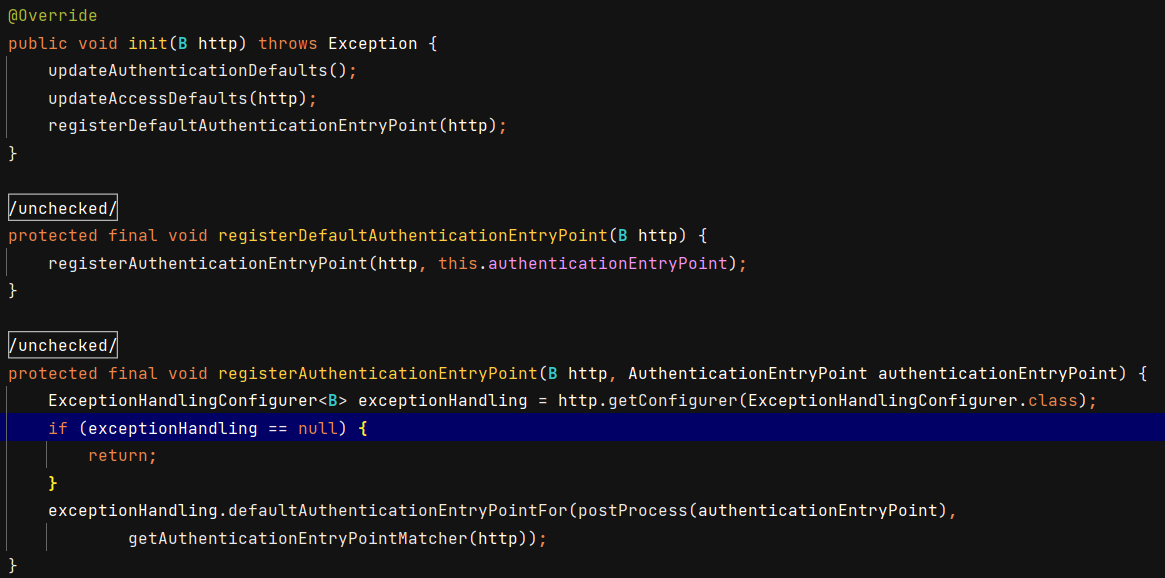
해당 클래스의 init 을 통해 초기화가 진행되는데 이때 registerDefaultAuthenticationEntryPoint() 메서드를 통해 ExceptionHandlingConfigurer 를 불러와서 자신의 EntryPoint 를 등록시킵니다.
마찬가지로 HttpBasicConfigurer 도 authenticationEntryPoint() 메서드로 동일한 작업을 거칩니다.
마지막으로 ExceptionHandlingConfigurer 는 configure() 메서드 실행 시 그렇게 받은 EntryPoint 를 ExceptionTranslationFilter 로 전달합니다. 해당 필터가 인증 예외 처리를 하기 때문입니다.

그러면 서비스 중 인증 예외가 발생했을 때 ExceptionTranslationFilter 의 sendStartAuthentication() 메서드에서 commence 를 통해 예외를 발생시킵니다.

시큐리티 인증 및 인가 흐름 요약
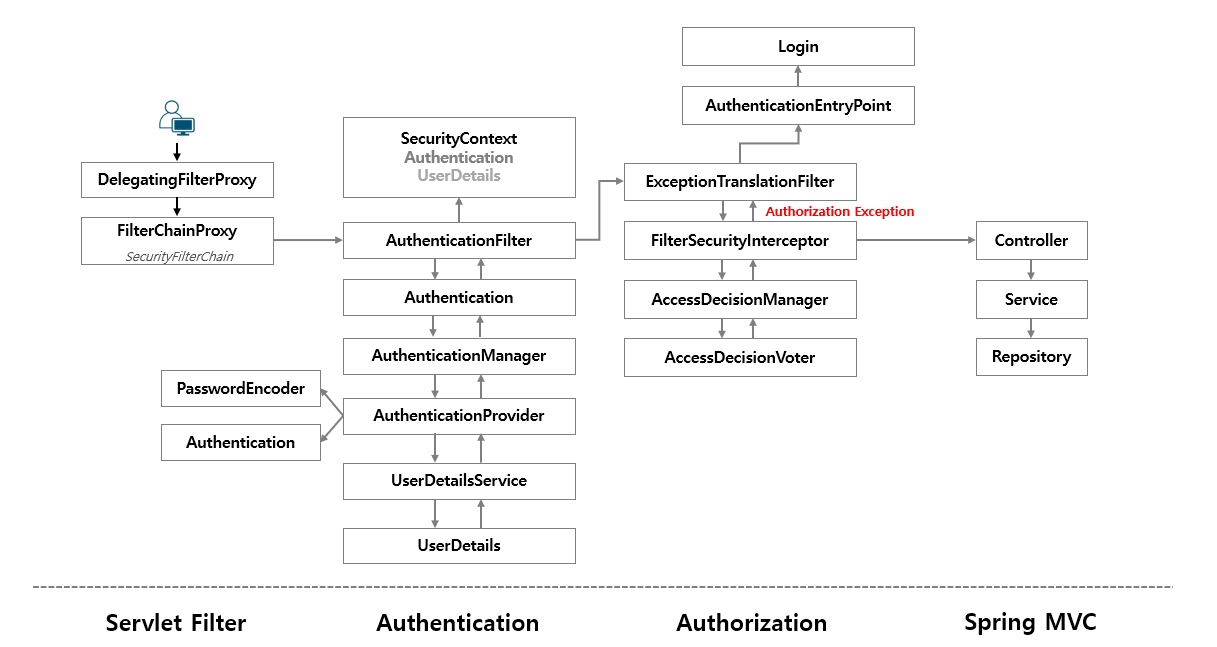
HttpBasic 인증
HttpBasic 인증 방식은 헤더에 ID, PW 를 인코딩해서 보내는 방식입니다.
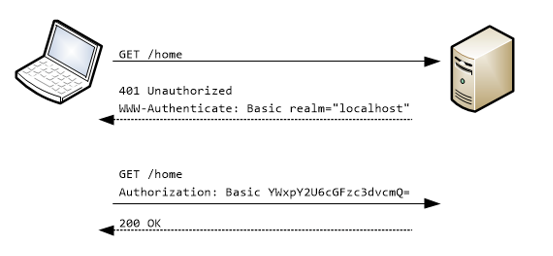
주의사항으로 base-64 인코딩된 값은 쉽게 디코딩할 수 있기 때문에 인증정보가 노출됩니다. 따라서 HTTP Basic 인증은 반드시 HTTPS 와 같이 TLS 기술과 함께 사용해야 합니다.
HttpBasicConfigurer
HttpBasic 설정 클래스입니다. 필터는 BasicAuthenticationFilter 를 사용하며 기본 AuthenticationEntryPoint 는 BasicAuthenticationEntryPoint 입니다.
BasicAuthenticationFilter
해당 필터 클래스는 BasicAuthenticationConverter 를 사용해서 요청 헤더에 기술된 인증정보의 유효성을 체크하며 Base64 인코딩된 ID 와 PW 를 추출합니다. 인증이 성공하면 Authenticatoin 이 SecurityContext 에 저장되고 인증이 실패하면 Basic 인증을 통해 다시 인증하라는 메시지를 표시하는 BasicAuthenticationEntryPoint 가 호출됩니다.
인증 이후 세션을 사용하는 경우와 사용하지 않는 경우에 따라 처리되는 흐름에 차이가 있습니다. 세션을 사용하는 경우 매 요청 마다 인증과정을 거치지 않으나 세션을 사용하지 않는 경우 매 요청마다 인증과정을 거쳐야 합니다.
흐름은 아래와 같습니다.

코드레벨
HttpBasicConfigurer
HttpBasicConfigurer 클래스의 configure 을 보면 BasicAuthenticationFilter 을 만들어서 authenticationManager 와 authenticationEntryPoint 을 할당해주는 걸 볼 수 있습니다.
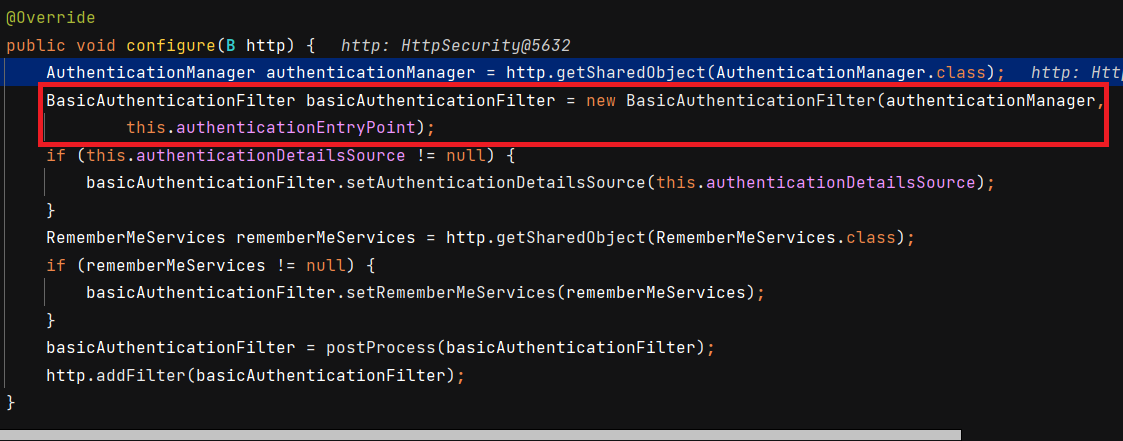
BasicAuthenticationFilter (헤더가 없을 때)

BasicAuthenticationFilter 에서 UsernamePasswordAuthenticationToken 은 header 에서 얻는데, 없다면 그대로 넘어간 뒤 Anonymous 객체가 되기 때문에 이후에 ExceptionTranslationFilter 에서 예외를 처리합니다.
ExceptionTranslationFilter
ExceptionTranslationFilter 에서는 예외를 처리하게 됩니다. 그러면 최종적으로 BasicAuthenticationEntryPoint 의 commence() 를 호출하게 됩니다.

해당 메서드에서는 repsonse 에 WWW-Authentication 헤더를 추가해 보냅니다.
BasicAuthenticationFilter (인증 성공)
먼저 로그인을 시도하면 아래와 같이 header 값이 추가됩니다.
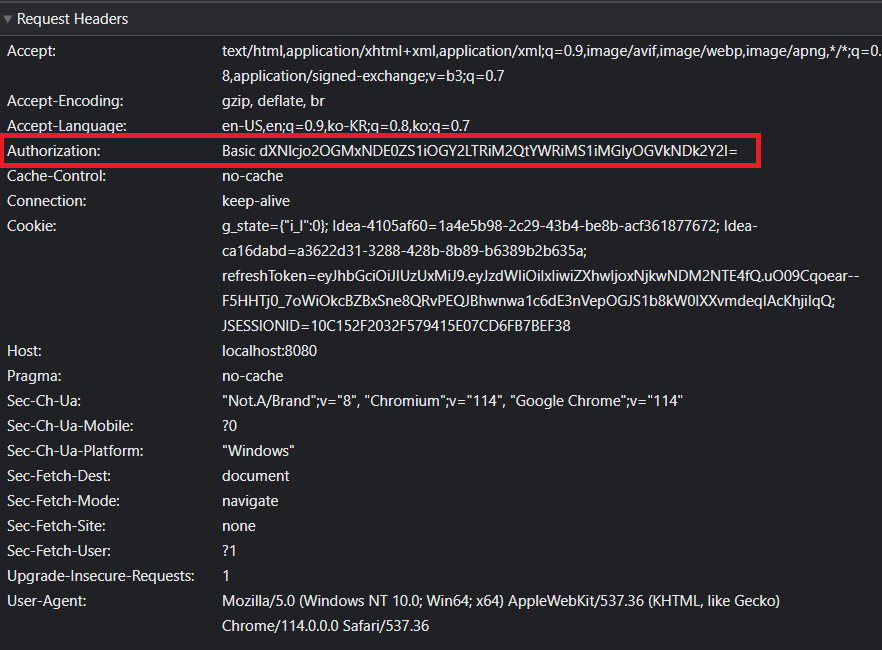
그리고 BasicAuthenticationFilter 클래스의 doFilterInternal() 에서 인증을 거칩니다.
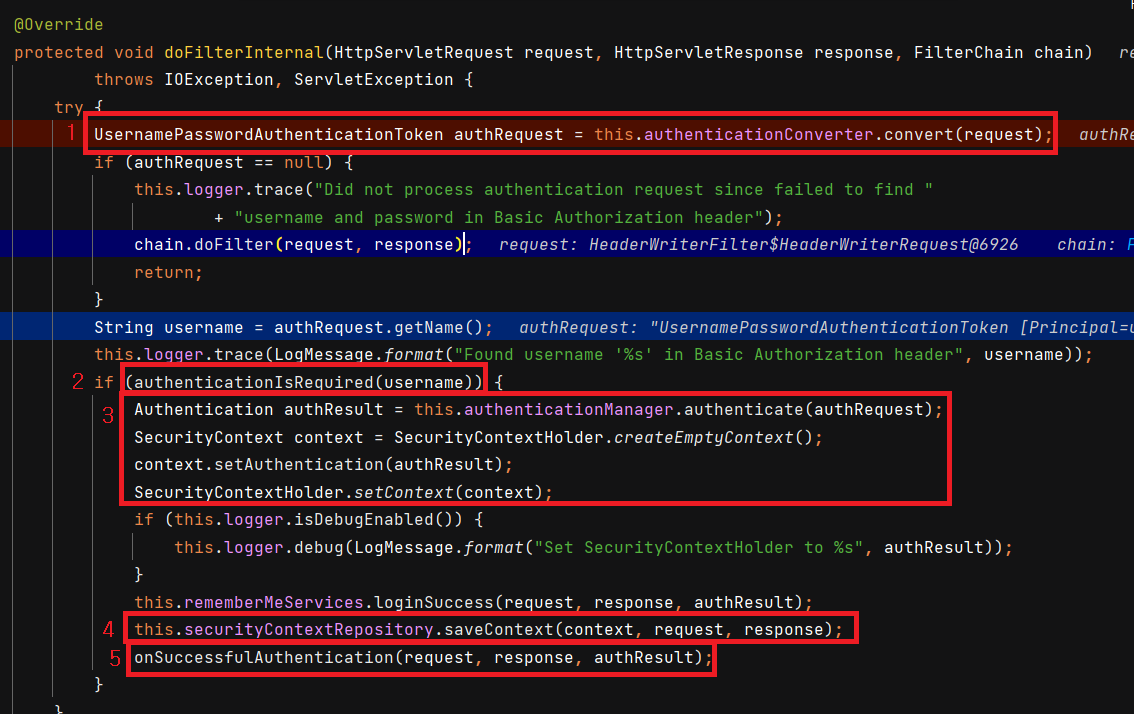
authenticationConverter로 request header 에서Authorization값을UsernamePasswordAuthenticationToken으로 변경합니다.- 인증이 필요한지 확인합니다.
SecurityContextHolder에Authentication값이 있거나 인증받은 객체인지 확인합니다. 세션에 인증값을 저장하면 한번만 로그인하면 해당 필터를 거치지 않습니다. Authentication객체를authenticationManager를 통해 인증한 후SecurityContextHolder에 저장합니다.Authentication객체를Session에 저장합니다.- 성공 핸들러를 실행합니다.
세션 무효화
만약 아래와 같이 세션을 무효화한다면 BasicAuthenticationFilter 에서 계속해서 인증을 실시하게 됩니다.
@Bean
public SecurityFilterChain securityFilterChain1(HttpSecurity http) throws Exception {
http
.httpBasic()
.and()
.authorizeRequests()
.anyRequest().authenticated()
.and()
.sessionManagement().sessionCreationPolicy(SessionCreationPolicy.STATELESS);
;
return http.build();
}
BasicAuthenticationFilter 의 2번 과정에서 true 를 반환하며 인증을 계속 실시합니다.
CustomAuthenticationEntryPoint
CustomAuthenticationEntryPoint 는 AuthenticationEntryPoint 클래스를 상속받고, commence() 메서드를 구현합니다.
package io.security.oauth2.springsecurityoauth2;
import org.springframework.http.HttpStatus;
import org.springframework.security.core.AuthenticationException;
import org.springframework.security.web.AuthenticationEntryPoint;
import javax.servlet.ServletException;
import javax.servlet.http.HttpServletRequest;
import javax.servlet.http.HttpServletResponse;
import java.io.IOException;
public class CustomAuthenticationEntryPoint implements AuthenticationEntryPoint{
@Override
public void commence(HttpServletRequest request, HttpServletResponse response,
AuthenticationException authException) throws IOException {
response.addHeader("WWW-Authenticate", "Basic realm= localhost");
response.sendError(HttpStatus.UNAUTHORIZED.value(), HttpStatus.UNAUTHORIZED.getReasonPhrase());
}
}
해당 메서드는 BasicAuthenticationEntryPoint 를 그대로 구현하고 Basic realm= localhost 부분만 변경하였습니다.
그리고 설정 파일에서 해당 entryPoint 를 httpBasic 에 줍니다.
@Configuration
public class SecurityConfig {
@Bean
public SecurityFilterChain securityFilterChain1(HttpSecurity http) throws Exception {
http
.httpBasic()
.authenticationEntryPoint(new CustomAuthenticationEntryPoint())
.and()
.authorizeRequests()
.anyRequest().authenticated()
.and()
.sessionManagement().sessionCreationPolicy(SessionCreationPolicy.STATELESS);
;
return http.build();
}
}
이제 다시 미인증상태로 리소스를 요청하면 아래와 같이 헤더값이 옵니다.
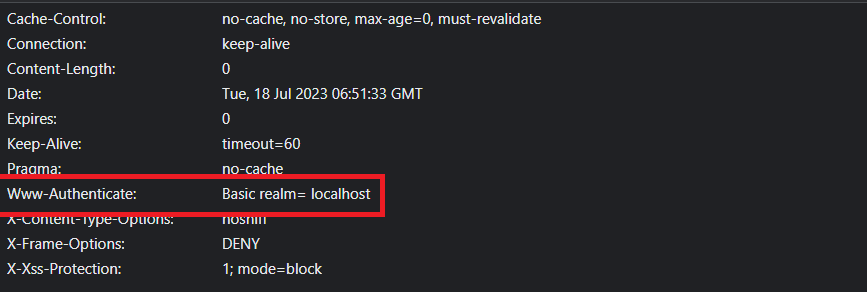
이때 header name 을 정확히 WWW-Authenticate 로 하지않는다면 로그인 페이지로 이동되지 않습니다!
CORS
CORS (Cross-Origin Resource Sharing) 은 교차 출처 리소스 공유로, HTTP 헤더를 사용하여 한 출처에서 실행 중인 웹 애플리케이션이 다른 출처의 선택한 자원에 접근할 수 있는 권한을 부여하도록 브라우저에 알려주는 체제입니다.
출처를 비교하는 로직은 서버에 구현된 스펙이 아닌 브라우저에 구현된 스펙 기준으로 처리되며 브라우저는 클라이언트의 요청 헤더와 서버의 응답헤더를 비교해서 최종 응답을 결정합니다. 두 개의 출처를 비교하는 방법은 URL의 구성요소 중 Protocol, Host, Port 세가지가 동일한지 확인하면 되고 나머지는 달라도 상관없습니다.
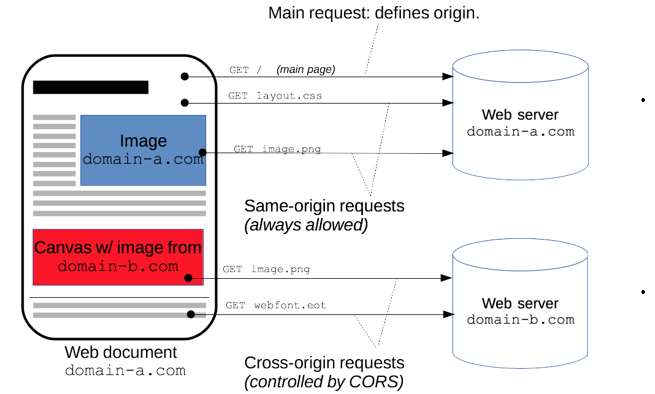
https://domain-a.com 의 프론트 엔드 JavaScript 코드가 XMLHttpRequest를 사용하여 https://domain-b.com/data.json 을 요청하는 경우 보안 상의 이유로, 브라우저는 스크립트에서 시작한 교차 출처 HTTP 요청을 제한합니다.

XMLHttpRequest와 Fetch API는 동일 출처 정책을 따르기 때문에 이 API를 사용하는 웹 애플리케이션은 자신의 출처와 동일한 리소스만 불러올 수 있으며, 다른 출처의 리소스를 불러오려면 그 출처에서 올바른 CORS 헤더를 포함한 응답을 반환해야 합니다.
CORS 요청의 종류
Simple Request
Simple Request 는 예비 요청(Prefilght)을 과정 없이 바로 서버에 본 요청을 한 후, 서버가 응답의 헤더에 Access-Control-Allow-Origin 과 같은 값을 전송하면 브라우저가 서로 비교 후 CORS 정책 위반여부를 검사하는 방식입니다.

GET, POST, HEAD 중의 한가지 Method 를 사용해야 하며, 헤더는 Accept, Accept-Language, Content-Language, Content-Type, DPR, Downlink, Save-Data, Viewport-Width Width 만 가능하고 Custom Header 는 허용되지 않습니다. Content-type 은 application/x-www-form-urlencoded, multipart/form-data, text/plain 만 가능합니다.
Preflight Request
Preflight Request 에서 브라우저는 요청을 한번에 보내지 않고, 예비요청과 본요청으로 나누어 서버에 전달하는데 브라우저가 예비요청을 보내는 것을 Preflight 라고 하며 이 예비요청의 메소드에는 OPTIONS 가 사용됩니다. 예비요청의 역할은 본 요청을 보내기 전에 브라우저 스스로 안전한 요청인지 확인하는 것으로 요청 사양이 Simple Request 에 해당하지 않을 경우 브라우저가 Preflight Request 을 실행합니다.
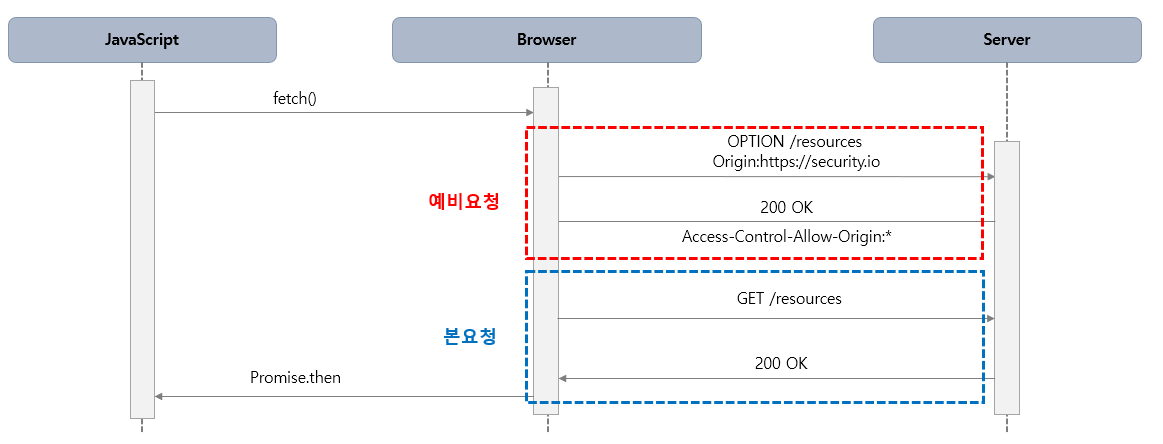
아래 코드가 Preflight Request 입니다. Content-Type 이 text/xml 로, Simple Request 에 해당하지 않으므로 Preflight Request 가 실행됩니다.
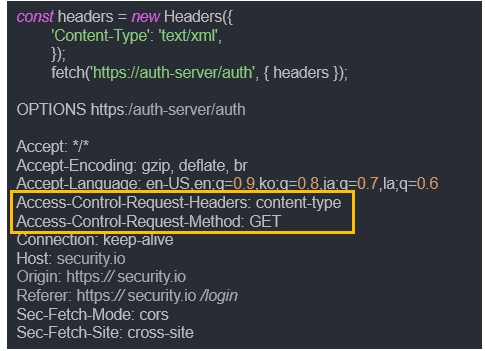
브라우저가 보낸 요청을 보면 Origin 에 대한 정보 뿐만 아니라 예비 요청 이후에 전송할 본 요청에 대한 다른 정보들도 함께 포함되어 있는 것을 볼 수 있습니다. 이 예비 요청에서 브라우저는 Access-Control-Request-Headers 를 사용하여 자신이 본 요청에서 Content-Type 헤더를 사용할 것을 알려주거나, Access-Control-Request-Method 를 사용하여 GET 메소드를 사용할 것을 서버에게 미리 알려주고 있습니다.
아래는 그에 따른 서버의 응답 메세지입니다.
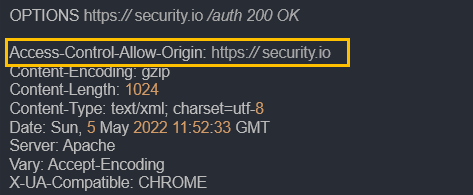
서버가 보내준 응답 헤더에 포함된 Access-Control-Allow-Origin: https://security.io 의 의미는 해당 URL 외의 다른 출처로 요청할 경우에는 CORS 정책을 위반했다고 판단하고 오류 메시지를 내고 응답을 버리게 된다는 뜻입니다.
아래는 https://security.io 과 동일 출처 기준입니다.

CORS 를 해결하기 위해서는 서버에서 Access-Control-Allow-* 을 세팅합니다.
- Access-Control-Allow-Origin - 헤더에 작성된 출처만 브라우저가 리소스를 접근할 수 있도록 허용합니다.
*,https://security.io
- Access-Control-Allow-Methods - preflight request 에 대한 응답으로 실제 요청 중에 사용할 수 있는 메서드를 나타냅니다.
- 기본값은 GET,POST,HEAD,OPTIONS, *
- Access-Control-Allow-Headers - preflight request 에 대한 응답으로 실제 요청 중에 사용할 수 있는 헤더 필드 이름을 나타냅니다.
- 기본값은 Origin,Accept,X-Requested-With,Content-Type, Access-Control-Request-Method,Access-Control-Request-Headers, Custom Header, *
- Access-Control-Allow-Credentials - 실제 요청에 쿠기나 인증 등의 사용자 자격 증명이 포함될 수 있음을 나타냅니다. Client의 credentials:include 일경우 true 가 필수입니다.
- Access-Control-Max-Age - preflight 요청 결과를 캐시 할 수 있는 시간을 나타내는 것으로 해당 시간동안은 preflight 요청을 다시 하지 않게 됩니다.
CorsConfigurer
- Spring Security 필터 체인에
CorsFilter를 추가합니다. corsFilter라는 이름의 Bean 이 제공되면 해당CorsFilter가 사용됩니다.corsFilter라는 이름의 Bean 이 없고CorsConfigurationSource빈이 정의된 경우 해당CorsConfiguration이 사용됩니다.CorsConfigurationSource빈이 정의되어 있지 않은 경우 Spring MVC가 클래스 경로에 있으면HandlerMappingIntrospector가 사용됩니다.
CorsFilter
- CORS 예비 요청을 처리하고 CORS 단순 및 본 요청을 가로채고, 제공된
CorsConfigurationSource를 통해 일치된 정책에 따라 CORS 응답 헤더와 같은 응답을 업데이트하기 위한 필터입니다. - Spring MVC Java 구성과 Spring MVC XML 네임스페이스에서 CORS 를 구성하는 대안이라 볼 수 있습니다. ( 예: @CorsOrigin)
- 스프링 웹에 의존하는 응용 프로그램이나 javax.servlet 에서 CORS 검사를 수행해야 하는 보안 제약 조건에 유용한 필터입니다.
Cors 예제
먼저 모듈을 분리해서 cors-1, cors-2 를 만듭니다. cors-1 은 프론트 역할, cors-2 는 서버 역할입니다.
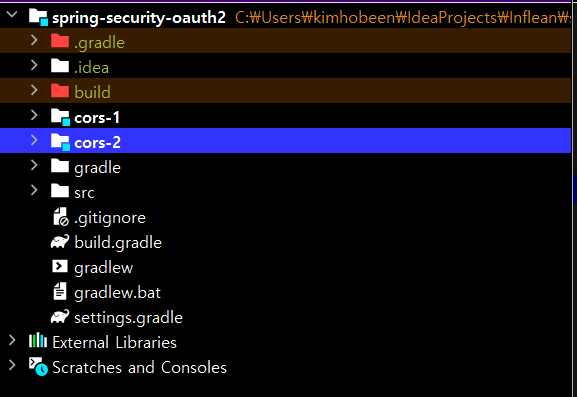
모듈은 Project Structure 에서 새로 만들 수 있습니다.
cors-1
cors-1 에는 간단한 컨트롤러와 index.html 이 있습니다.
@Controller
public class Cors1Controller {
@GetMapping("/")
public String index(){
return "index";
}
}
<!DOCTYPE html>
<html lang="en">
<head>
<meta charset="UTF-8">
<title>Title</title>
<script>
function corsTest(){
fetch("http://localhost:8081/api/users", {
method: "GET",
headers: {
"Content-Type": "text/xml",
}
}).then(response => {
response.json().then(data => {
console.log(data);
});
});
}
</script>
</head>
<body>
<button name="corsTest" onclick="corsTest()">CORS Test</button>
</body>
</html>
cors-2
cors-2 는 Controller 와 SecurityConfig 가 있습니다.
@RestController
@RequestMapping("/api")
public class Cors2Controller {
@GetMapping("/users")
public User users(){
return new User("user", 20);
}
}
public class User {
private String username;
private int age;
public User() {}
public User(String username, int age) {
this.username = username;
this.age = age;
}
//getter, setter
}
@Configuration
public class SecurityConfig {
@Bean
public SecurityFilterChain securityFilterChain(HttpSecurity http) throws Exception {
http
.authorizeRequests()
.anyRequest().authenticated()
.and()
.cors().configurationSource(corsConfigurationSource());
return http.build();
}
@Bean
public CorsConfigurationSource corsConfigurationSource() {
CorsConfiguration configuration = new CorsConfiguration();
configuration.addAllowedOrigin("*");
configuration.addAllowedMethod("*");
configuration.addAllowedHeader("*");
// configuration.setAllowCredentials(true);
configuration.setMaxAge(3600L); //default 는 1800
UrlBasedCorsConfigurationSource source = new UrlBasedCorsConfigurationSource();
source.registerCorsConfiguration("/**", configuration);
return source;
}
}
http 에 CorsConfigurationSource 을 빈으로 등록해서 적용합니다.
cors-1 을 실행시키면 8080 포트로 아래와 같이 생깁니다.
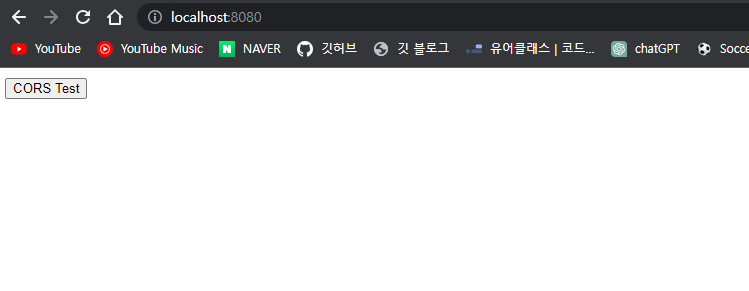
버튼을 누르면 아래와 같이 Cors 정책이 적용된 응답을 받습니다.
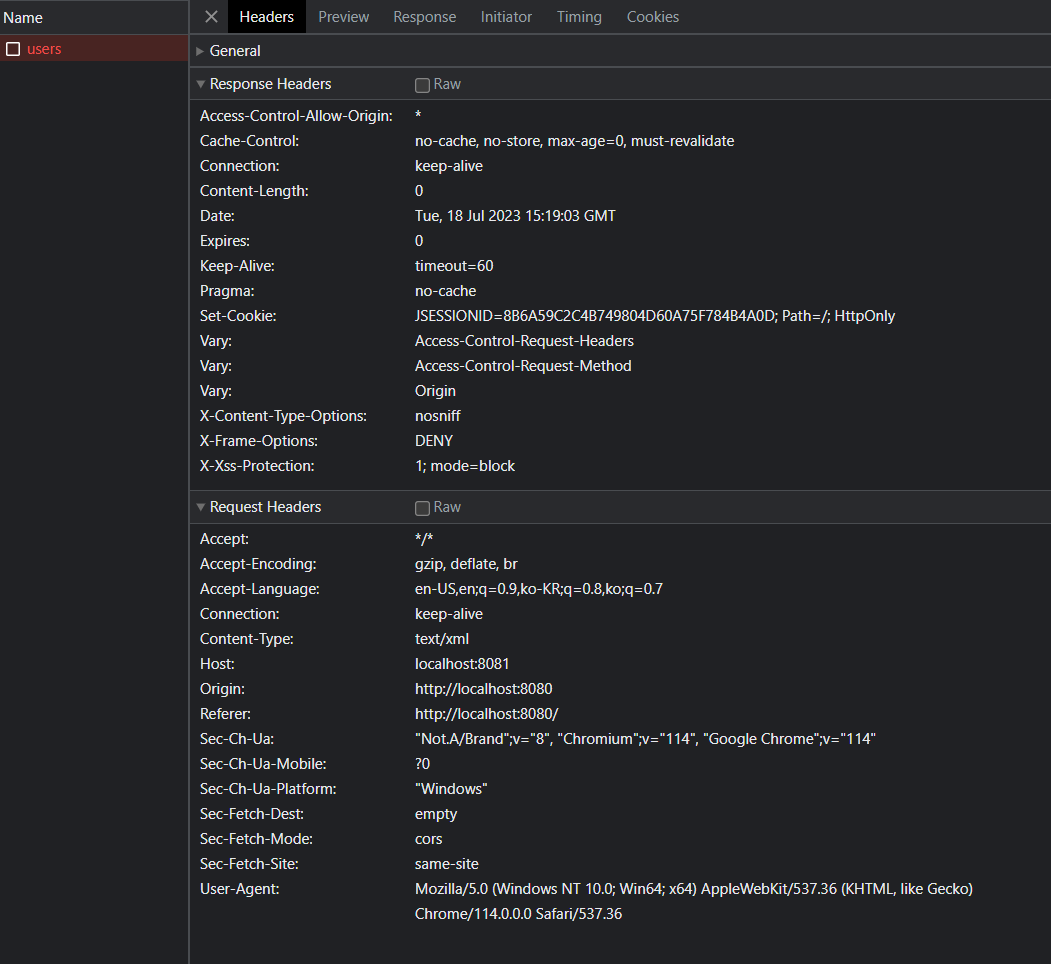
Cors 흐름
CorsConfigurer
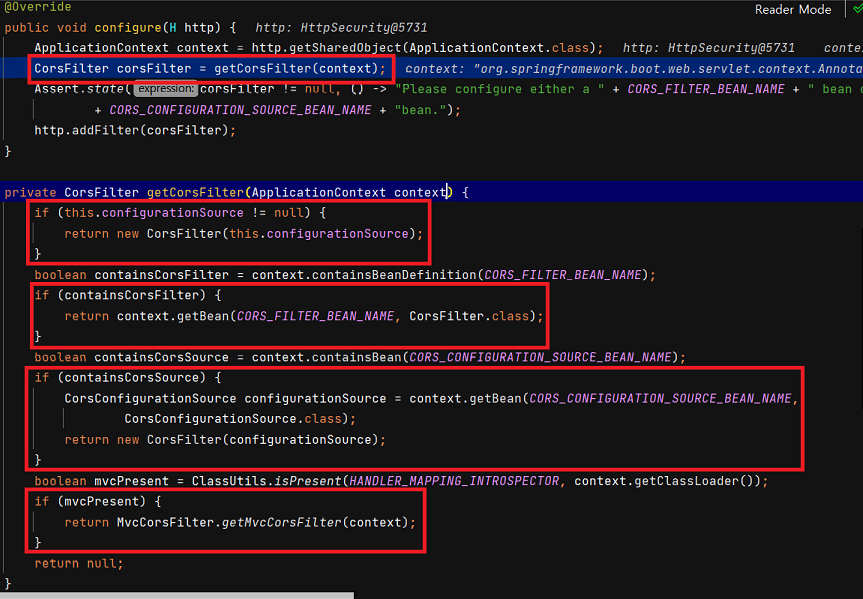
CorsConfigurer 클래스의 configure() 메서드에서 getCorsFilter() 를 통해 CorsFilter 를 생성합니다. 이 때 등록된 configurationSource 가 있으면 해당 객체로 생성하는데요. 현재 SecurityConfig 파일에 등록되어 있습니다. 그게 아니면 빈으로 등록된 CorsFilter 를 찾고, 없으면 빈으로 등록된 CorsConfigurationSource 를 찾습니다. 마지막으로 HandlerMappingIntrospector 가 적용됩니다.
CorsFilter
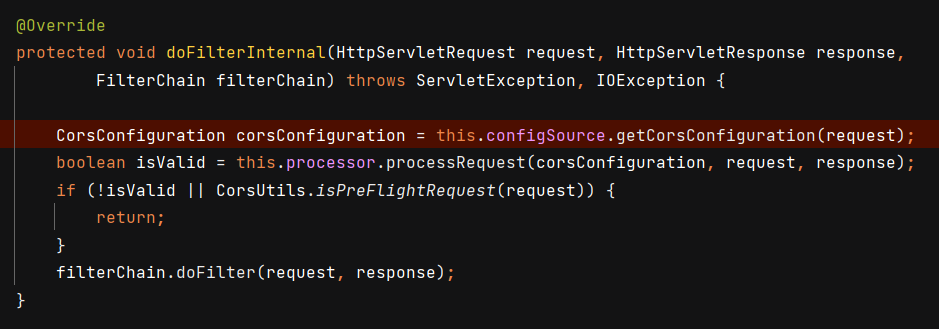
CorsFilter 의 doFilter 입니다. 가지고 있는 CorsConfiguration 정보로 Cors 정책을 판단하고 유효한지에 따라 그대로 return 을 하든지 다음 필터를 호출합니다.
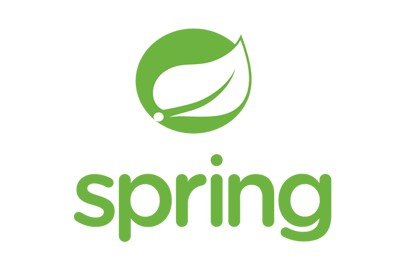


댓글남기기